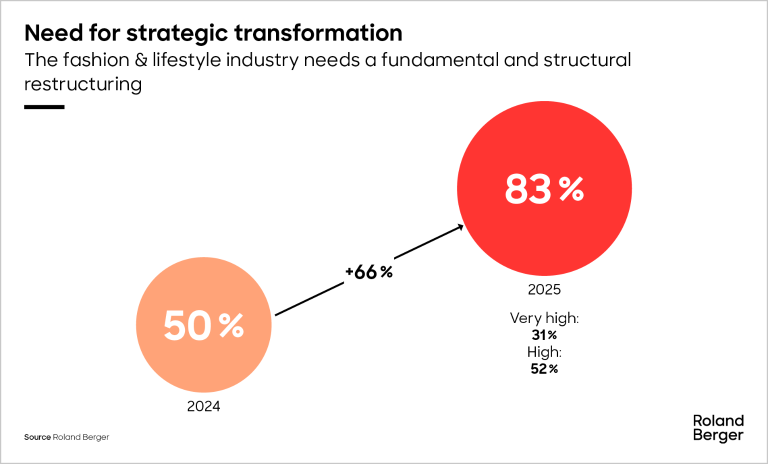Brands and retailers in the lifestyle & luxury industry are facing a growing number of challenges. Roland Berger's expert consulting services can help them thrive amid the uncertainty.


CFO survey: The acid test continues for the fashion & lifestyle industry
There is no way around a fundamental transformation
What are CFOs in the fashion and lifestyle industry expecting for 2025? Where do they anticipate the biggest challenges and what measures are they planning to take to tackle them? To find out, we conducted a survey between December 2024 and January 2025, canvassing the opinions of CFOs from leading companies across Germany, Austria, and Switzerland, as we do every year for our annual CFO survey.

The results paint a picture of an industry facing change. Germany's gloomy economic outlook is the main reason behind respondents' concerns about the future. Seventy percent of CFOs expect revenues to stagnate on a low level this year. Although all segments of the market will be affected by a further deterioration in operating conditions, the mainstream segment will be particularly hard hit. In contrast, the luxury and premium segment and the entry-level segment are proving relatively resilient to the crisis.
While company revenues are already under pressure given the weak economic outlook for 2025, respondents face additional challenges as a result of further cost rises. However, the increases will not be as significant as last year: Whereas CFOs anticipated an average rise of 8% for personnel and logistics costs in 2024, the estimate for this year is "just" 4%.
"The industry is in crisis for the third year in a row. The potential for quick wins is exhausted, and fire-fighting cannot bring lasting relief. There is no way around a fundamental transformation. "
Already last year, half of the CFOs were convinced that companies in the industry needed to strategically reposition themselves. By now, this number has risen significantly – to 83 percent. The majority agrees that superficial symptom management is no longer sufficient; quick wins are becoming increasingly rare. What the industry needs is a fundamental transformation that puts the entire value chain in focus. In doing so, companies face a dilemma: on the one hand, the current situation demands strict cost discipline; on the other hand, urgent investments in the future are necessary to ensure long-term survival.
"Now is the time to critically question the status quo and courageously tackle far-reaching changes. Numerous successful fashion and lifestyle brands and retailers show that it is possible to operate successfully in this market."
In a dilemma between downsizing and a shortage of skilled workers
Last year, half of CFOs were convinced that companies in the industry were in need of a complete strategic repositioning. That figure has now risen significantly to 83%. The majority agree that tinkering around the edges is no longer enough – there are few quick wins left to be had.
Even downsizing is not unthinkable. Indeed, seven out of ten companies have already cut staff numbers or are currently in the process of doing so, while a further 15% have plans to reduce their headcount. Marketing and Sales are the main areas of focus, but management as well as Finance, Accounting, and Controlling are also in the firing line. "Soft" downsizing such as not filling vacant positions is currently the method of choice.
At the same time, almost 60% of companies say they are struggling with the impact of the skills shortage. Respondents believe that companies themselves are less to blame for the skills shortage than external factors that are almost impossible to influence. These include the general war for talent, job applicants' inflated salary expectations, and demographic change. Internal, home-made causes include locational disadvantages as a result of regional disparities.
What is needed now: A complete overhaul, no piecemeal efforts
The industry is in crisis for the third year in a row. The potential for quick wins is exhausted, and fire-fighting cannot bring lasting relief. There is no getting away from the realization that companies need to tackle their structural problems now. The fact that the investments required for the transformation break all the rules of strict cost discipline and that there is no relief to be expected from the top line serves to exacerbate things. In this situation, four key approaches are vital – along with a CFO who can set the pace throughout the whole transformation process:
To get out of the crisis, fashion & lifestyle companies must, among other things, sharpen their business model (e.g., have a clear reason why), improve shopfloor performance, and cut costs even more in human resources. But above all, they need CFOs who know what they are doing – and who are prepared to take more responsibility for shaping the future.
Co-authors of the article are Lucas Heer and Svenja Moltrecht.
Register now to access the full study and explore the continuous transformation shaping the fashion industry. Furthermore, you get regular news and updates directly in your inbox.


_person_144.png)




